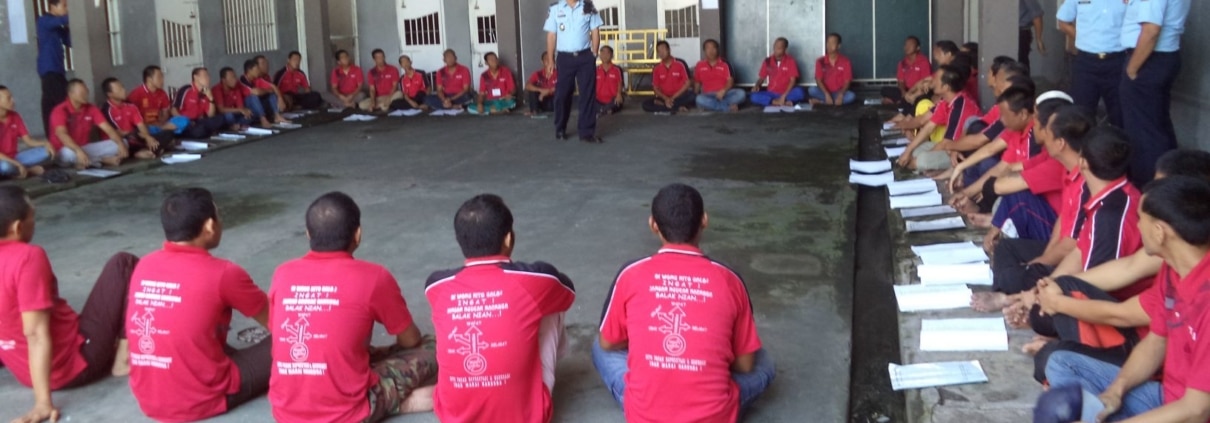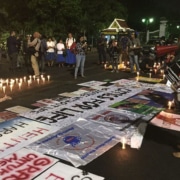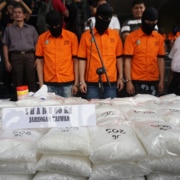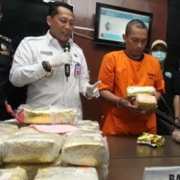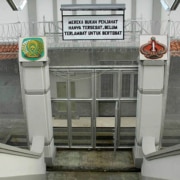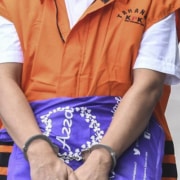
Drug convicts participate in a rehabilitation program in Lubuklinggau Narcotics Prison in South Sumatra. Photo by the Directorate General of Corrections.
In 2015, the government began implementing a rehabilitation program for drug convicts in Indonesian prisons, with the support of the conservative National Narcotics Agency (BNN). But this support did not last long. Just two years later, BNN withdrew its support, apparently because of ongoing circulation of drugs in Indonesian prisons.
Since then, the Ministry of Law and Human Rights has been running the program independently in 128 of Indonesia’s more than 500 prisons and detention facilities. The ministry has a massive challenge ahead if it is to effectively implement rehabilitation.
One reason for this is the problem of overcrowding in Indonesian prisons. This is a problem the country has had for more than a decade, but it has got much worse since the escalation of the ‘war on drugs’ in Indonesia in 2015. According to the most recent data from the Directorate General of Corrections, there are currently more than 253,000 inmates in Indonesian prisons and detention centres, which were only designed to accommodate up to 135,000 people. This puts them at 187% overcapacity.
The problem is closely related to drug use. A huge proportion of Indonesians charged with drug offences are sentenced to time in prison, rather than diverted to rehabilitation programs. As a result, more than half of inmates in Indonesian prisons are now drug convicts, and it is hard to imagine how the ministry could provide rehabilitation services for them all.
In fact, the challenge cannot be overcome by the ministry alone. There is little use in it focusing on rehabilitation in prisons if the police and the courts keep sending people to prisons in huge numbers for just minor drug offences.
Moreover, drug rehabilitation programs cost a lot of money. Indonesia has begun to make attempts to implement the ‘therapeutic community’ (TC) model of rehabilitation. This approach is focused on recovery rather than simply abstinence, and involves creating a positive social environment in which the community promotes personal change through self-help and mutual support.
This approach needs a large amount of facilities, staff and funding. Turning first to facilities, this approach requires a dedicated block, separate from other inmates, where individuals can live together in a village-style environment, rather than an institutionalised setting.
This is just not happening. As one prison employee (rehabilitation staff) told the HIV/AIDS Research Centre (PPH) at Atma Jaya University in 2019:
“For the rehabilitation program in prisons, we just follow the BNN standard. In prisons there is nothing, especially in terms of facilities. We don’t have a special block, we just use rooms from one block as dedicated rehabilitation rooms. None of our staff have been trained. The ministry just says ‘follow the implementation guidelines and you are implementing the TC approach’.”
In addition to inadequate facilities, rehabilitation programs are grossly underfunded. Ministry guidelines only provide enough funding for 30 inmates from each participating prison or detention centre to join the rehabilitation program every six months. This means only 60 inmates from each institution can join the program each year. A majority of drug convicts therefore miss out on their needs for rehabilitation and recovery.
“For the rehabilitation program in prisons, we just follow the BNN standard. In prisons there is nothing, especially in terms of facilities. We don’t have a special block, we just use rooms from one block as dedicated rehabilitation rooms. None of our staff have been trained. The ministry just says ‘follow the implementation guidelines and you are implementing the TC approach’.”
Another major obstacle for the implementation of rehabilitation programs in Indonesian prisons is the lack of appropriate staff. Adequately trained staff, who understand the challenging nature of substance use problems, are key to the success of TC models of rehabilitation.
Ministry guidelines state that each prison rehabilitation program must be run by a trained manager, a daily instructor and an addiction counsellor. But not all the prisons selected to run rehabilitation programs are able to supply this many staff. In fact, PPH Atma Jaya identified many prisons implementing rehabilitation programs that lacked even a single addiction counsellor.
Following participation in a rehabilitation program and release back into the community, inmates should then have ‘aftercare’ services available. The ministry dictates these services should be provided by the local Corrections Board (Bapas), which also supervises parole for released inmates. But PPH Atma Jaya research has identified that only a very small number of drug convicts go on to participate in aftercare programs following their release. This obviously has a major impact on the sustainability of recovery efforts.
Given the dire state of the government’s rehabilitation program, one might then ask what is the point of running a rehabilitation program if it is not sufficiently funded?
The answer is that the government has yet to demonstrate a serious commitment to rehabilitation. The program is running but there is little effort to make sure that it works for people who use drugs and achieves its stated goals.
Ideally, rehabilitation programs should not be run in prisons. People who use drugs or people with drug dependence should receive care in the dedicated drug rehabilitation centres or institutions run by non-corrective institutions, such as those managed by the Ministry of Social Affairs, the Ministry of Health, the community, or even those managed by the BNN.
In fact, the problem of drug dependence should be dealt with at the time of arrest. If police identify that a person arrested for drug offences is an addict, they should be immediately referred to a rehabilitation centre. Only after they have undergone rehabilitation should they serve any sentence handed down.
Instead of putting half-hearted efforts into rehabilitation programs in prisons, Indonesia should be strengthening the assessment and referral process at the time of arrest, so that people who use drugs get the treatment they need, and the country’s prisons do not continue to be overcrowded with prisoners serving time for what are often quite minor drug offences.
The funds that have been poured into the ineffective drug rehabilitation program could then be used to improve other priority rehabilitation and healthcare programs for inmates, in areas such as hygiene, nutrition and infectious disease control.


